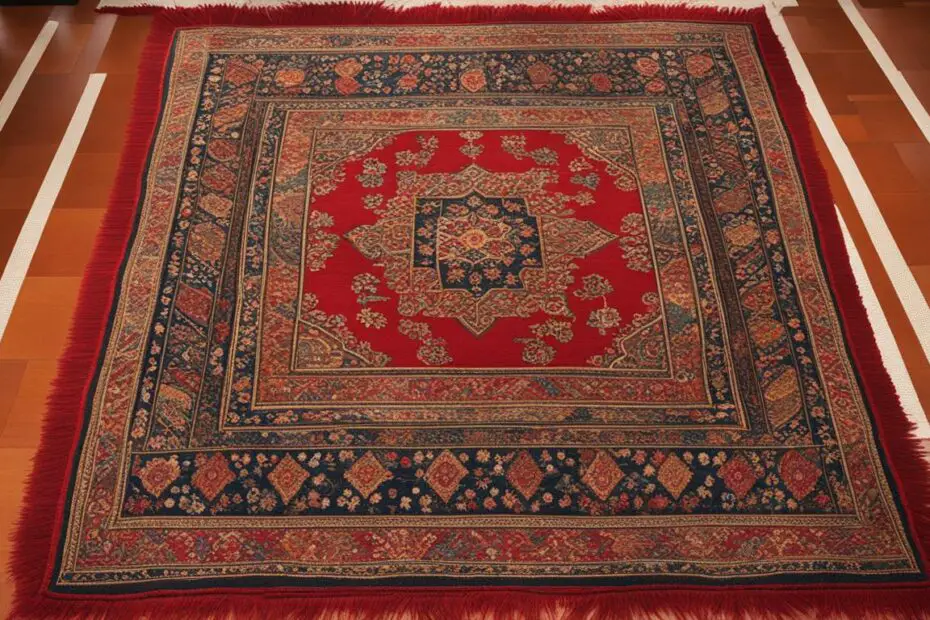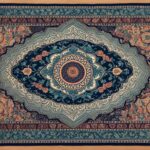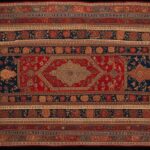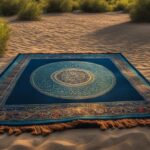Prayer mats have a long and rich history, dating back centuries. They are an essential part of Islamic prayer rituals, providing a clean and sacred space for worshippers. The design and symbolism of prayer mats have evolved over time, reflecting cultural and artistic influences. These mats hold great historical significance, representing the spiritual journey of individuals and communities. Let’s delve deeper into the fascinating history of prayer mats.
Key Takeaways:
- Prayer mats have a deep historical significance in Islamic culture.
- They have evolved in design and craftsmanship, incorporating diverse patterns and motifs.
- Prayer mats are not only functional but also highly regarded as works of art.
- The symbolism of prayer mats reflects the beauty and order of the natural world.
- These mats provide a sacred space for prayer and connection to faith.
The Origins and Evolution of Prayer Mats
The history of prayer mats dates back centuries, with their origins rooted in the Islamic Golden Age of the 8th century. Initially made of simple materials like wool, cotton, and plant fibers, prayer mats have evolved in design and craftsmanship over time.
During the early stages, prayer mats served a functional purpose, providing a clean and sacred space for worshippers to perform their prayers. However, as Islamic art and culture flourished, prayer mats became more than just a practical tool. They transformed into intricate works of art, reflecting the diverse traditions and artistic styles of different regions.
The cultural significance of prayer rugs became apparent as they incorporated geometric patterns, intricate motifs, and vibrant colors. These designs symbolized purity, humility, and the spiritual connection to the divine. Prayer mats were not only a means of facilitating prayer but also a representation of artistic creativity and a reflection of cultural identity.
As prayer mats spread to different parts of the world, they assimilated local artistic traditions, resulting in unique patterns and styles. In the Middle East, geometric patterns and floral motifs were commonly seen, symbolizing the harmony and beauty of the natural world. Central Asian prayer mats often featured intricate medallion designs and rich colors inspired by Persian and Turkic influences.
The evolution of prayer mat patterns reflects the interplay between artistic creativity and religious symbolism, creating a diverse and culturally rich heritage. These prayer mats, once simple mats made for prayer, have become artistic masterpieces that showcase the historical development and cultural significance of prayer rugs.
Traditional Designs and Patterns
Traditional prayer mat designs are a testament to the rich cultural heritage of Islamic communities. These designs vary across different cultures and regions, reflecting the diverse artistic traditions and influences. Let’s explore some of the notable traditional designs and patterns found in prayer mats.
1. Geometric Patterns and Floral Motifs
In the Middle East, prayer mats often feature geometric patterns and floral motifs. These designs represent the harmony and beauty of the natural world. Geometric shapes such as squares, rectangles, and diamonds are intricately woven into the mat, symbolizing order and balance. The floral motifs, on the other hand, represent the beauty and abundance of nature. These patterns not only add aesthetic appeal but also create a serene and peaceful environment for prayer.
2. Intricate Medallion Designs and Rich Colors
In Central Asia, prayer mats showcase intricate medallion designs and vibrant colors. These designs are inspired by Persian and Turkic artistic traditions. The medallion, often located at the center of the mat, is a symbol of unity and wholeness. Surrounding the medallion, you’ll find elaborate patterns and borders, featuring motifs such as leaves, vines, and intricate floral elements. The rich colors used in Central Asian prayer mats reflect the region’s love for bold and expressive hues.
3. Assimilation of Local Artistic Traditions
As prayer mats spread to different parts of the world, they assimilated local artistic traditions, resulting in unique patterns and styles. For example, in North Africa, prayer mats often incorporate Berber designs, characterized by geometric shapes and symbols. In Southeast Asia, prayer mats may feature batik patterns or traditional textile designs specific to that region. This assimilation of local artistic traditions not only adds diversity to prayer mat designs but also reflects the cultural fusion and exchange that has taken place over centuries.
Traditional prayer mat designs are not only visually striking but also carry deep symbolic meaning. They are a visual representation of the unity, beauty, and spirituality that prayer entails. These designs have evolved over time, reflecting the evolution of Islamic art and the influence of different cultures. Prayer mats continue to be cherished as cultural artifacts and symbols of devotion, carrying with them the rich history and artistic legacy of Islamic communities.
Prayer Mats as Works of Art
Prayer mats are not just functional accessories for Islamic worship; they are highly regarded as works of art. Antique prayer mats, with their intricate designs and expert craftsmanship, are considered prized possessions by collectors and revered as cultural treasures. These rugs offer a glimpse into different historical periods and artistic traditions, showcasing the evolution of prayer mat patterns throughout the centuries.
Throughout history, prayer mats have undergone significant transformations in design and aesthetics, reflecting the diverse influences of various regions and cultures. The evolution of prayer mat patterns demonstrates the creativity and skill of generations of weavers, as well as the interplay between artistic expression and spiritual symbolism. The combination of geometric shapes, floral motifs, and vibrant colors creates visually stunning pieces that captivate the eye and inspire awe.
“Antique prayer mats, adorned with intricate designs and expert craftsmanship, are highly sought after by collectors and museums.”
The intricate patterns and motifs on prayer mats serve as a testament to the artistic heritage of Islamic communities. These designs often draw inspiration from nature, depicting elements such as flowers, leaves, and stars, symbolizing purity, growth, and spirituality. Each pattern and motif carries its own meaning, reflecting the cultural and spiritual values of the community from which it originated.

Evolution of Prayer Mat Patterns
| Period | Prayer Mat Patterns | Key Features |
|---|---|---|
| 8th to 13th century | Mosaic-style patterns | Geometric shapes, repetitive motifs |
| 14th to 17th century | Floral motifs | Intricate flower designs, stylized leaves |
| 18th to 19th century | Central medallion | Central focal point with surrounding borders |
| 20th century onwards | Abstract patterns | Modern interpretations, experimentation with color and form |
As the centuries passed, prayer mat patterns underwent gradual transformations. From the simplistic mosaic-style patterns of the early Islamic era to the highly detailed floral motifs of the medieval period, each style represents a distinct artistic expression and cultural influence.
The modern era has seen a resurgence of interest in prayer mat design, with artists and designers pushing the boundaries of tradition to create innovative and abstract patterns. These contemporary prayer mats often feature bold colors, unconventional shapes, and experimental compositions, appealing to both traditionalists and those seeking unique interpretations of their faith.
Symbolism and Spiritual Significance
Islamic prayer mats have evolved over time, not only as functional items but also as powerful symbols of spirituality and devotion. These mats hold deep symbolism in Islamic culture, representing the sacred space where individuals connect with the divine during prayer. By using a prayer mat, Muslims ensure cleanliness and purity before engaging in prayer, as worshippers perform ablution, a ritual cleansing, before entering into a state of worship.
The act of laying the prayer mat and orienting it towards Mecca, the holy city of Islam, is a physical representation of the spiritual journey towards God. It signifies the importance of focus and direction during prayer, reminding the worshipper of their connection to the central pillar of Islamic faith. The prayer mat serves as a dedicated space for uninterrupted communication with the divine, allowing individuals to immerse themselves fully in their prayers and to detach from worldly distractions.
“The prayer mat is a sacred tool that facilitates our connection with Allah. It is a personal sanctuary, a space of solitude, where we can commune with God and seek His blessings,” says Sheikh Ahmed, an Islamic scholar.
Besides its functional and symbolic aspects, the intricate designs and patterns on prayer mats also carry deeper meaning. These patterns often reflect the beauty and order of the natural world, reminding the worshipper of the divine creations and the need for humility and reverence in the face of God’s grandeur. Each geometric shape, floral motif, or color choice holds significance, igniting contemplation and spiritual reflection during prayers.
The Cultural Significance of Prayer Rugs
Islamic prayer mats not only have religious importance but also embody the cultural heritage and diversity of Islamic communities worldwide. As prayer mats spread to different regions, they assimilated local artistic traditions, resulting in a wide variety of patterns, styles, and materials. This cultural integration is a testament to the adaptability and inclusivity of Islamic traditions, embracing the artistic expressions of various cultures while maintaining the core principles of faith.
Moreover, prayer mats have become a cherished part of family heirlooms and artistic collections. Antique prayer mats, adorned with intricate designs and expert craftsmanship, are highly sought after by collectors and museums. These rugs provide a glimpse into different historical periods and artistic traditions, preserving the cultural legacy of prayer mat weaving for future generations.
| Region | Distinctive Characteristics |
|---|---|
| Middle East | Geometric patterns and floral motifs representing harmony and beauty. |
| Central Asia | Intricate medallion designs and vibrant colors influenced by Persian and Turkic styles. |
| South Asia | Richly embroidered prayer mats with cultural motifs and intricate stitching. |
| North Africa | Berber-inspired patterns and symbolism reflecting the region’s indigenous cultures. |
The diverse range of prayer mat designs and styles is a testament to the global reach of Islam and its ability to adapt and thrive in different cultural contexts. It underscores the cultural significance of prayer rugs as more than just functional items, but expressions of identity, creativity, and devotion.
Conclusion
The rich legacy of prayer mat history spans centuries, showcasing the cultural, artistic, and spiritual development within Islamic communities. From humble beginnings to intricate designs, prayer mats have evolved over time, reflecting the diverse traditions and beliefs of worshippers. These mats are not only functional but also revered as works of art, with antique prayer mats held in high esteem by collectors and museums.
Symbolism and spiritual significance are deeply embedded in the use of prayer mats. They provide a sacred space for worshippers to connect with the divine during prayer, ensuring cleanliness and purity through the act of ablution. The placement and orientation of the mat toward Mecca symbolize the spiritual journey towards God, while the intricate designs and patterns serve as a reminder of the beauty and order of the natural world.
The history of prayer mats is a testament to the enduring value and beauty of religious rituals and traditions. Their evolution represents the artistic creativity and skill of generations of weavers, resulting in visually stunning pieces that are both aesthetically pleasing and spiritually meaningful. As worshippers continue to find solace and connection through prayer mats, this rich history will continue to inspire and enrich spiritual journeys for generations to come.
FAQ
What is the historical significance of prayer mats?
Prayer mats have a long and rich history, dating back centuries. They represent the sacred space where individuals connect with the divine during Islamic prayer rituals. They also symbolize purity, humility, and the spiritual journey towards God.
How have prayer mats evolved over time?
Prayer mats initially started as simple mats made of materials like wool, cotton, and plant fibers. Over time, they evolved in design and craftsmanship, incorporating intricate motifs, geometric patterns, and vibrant colors. They assimilated regional artistic traditions resulting in diverse patterns and styles.
What is the cultural importance of traditional prayer mat designs?
Traditional prayer mat designs vary across different cultures and regions. In the Middle East, they commonly feature geometric patterns and floral motifs, reflecting the beauty of the natural world. In Central Asia, prayer mats often have intricate medallion designs and rich colors inspired by Persian and Turkic influences. These designs represent cultural identity and artistic traditions.
Are prayer mats considered works of art?
Yes, prayer mats are highly regarded as works of art. Antique prayer mats with intricate designs and expert craftsmanship are sought after by collectors and museums. They provide insight into different historical periods and artistic traditions. The combination of geometric shapes, floral motifs, and vibrant colors creates visually stunning pieces.
What is the significance of symbolism in prayer mats?
The intricate designs and patterns on prayer mats carry symbolic meaning. They reflect the beauty and order of the natural world and serve as a reminder of the importance of faith. Prayer mats also symbolize purity and the spiritual journey of individuals and communities.
How do prayer mats connect individuals to their faith?
Prayer mats provide a sacred space for prayer and ensure cleanliness and purity during Islamic rituals. The act of laying the mat and orienting it towards Mecca physically represents the spiritual journey towards God. Using a prayer mat is a way for worshippers to connect with the divine and their faith.









